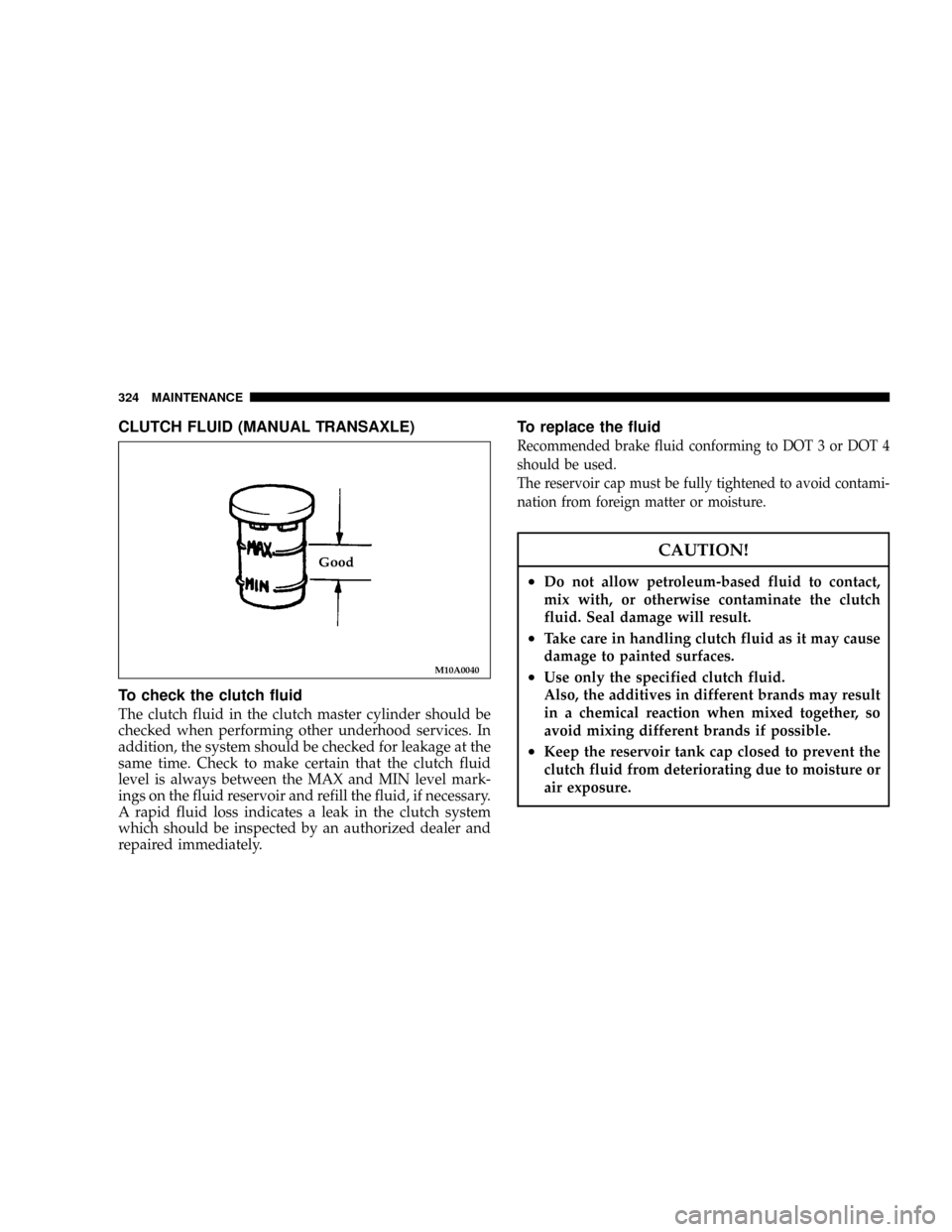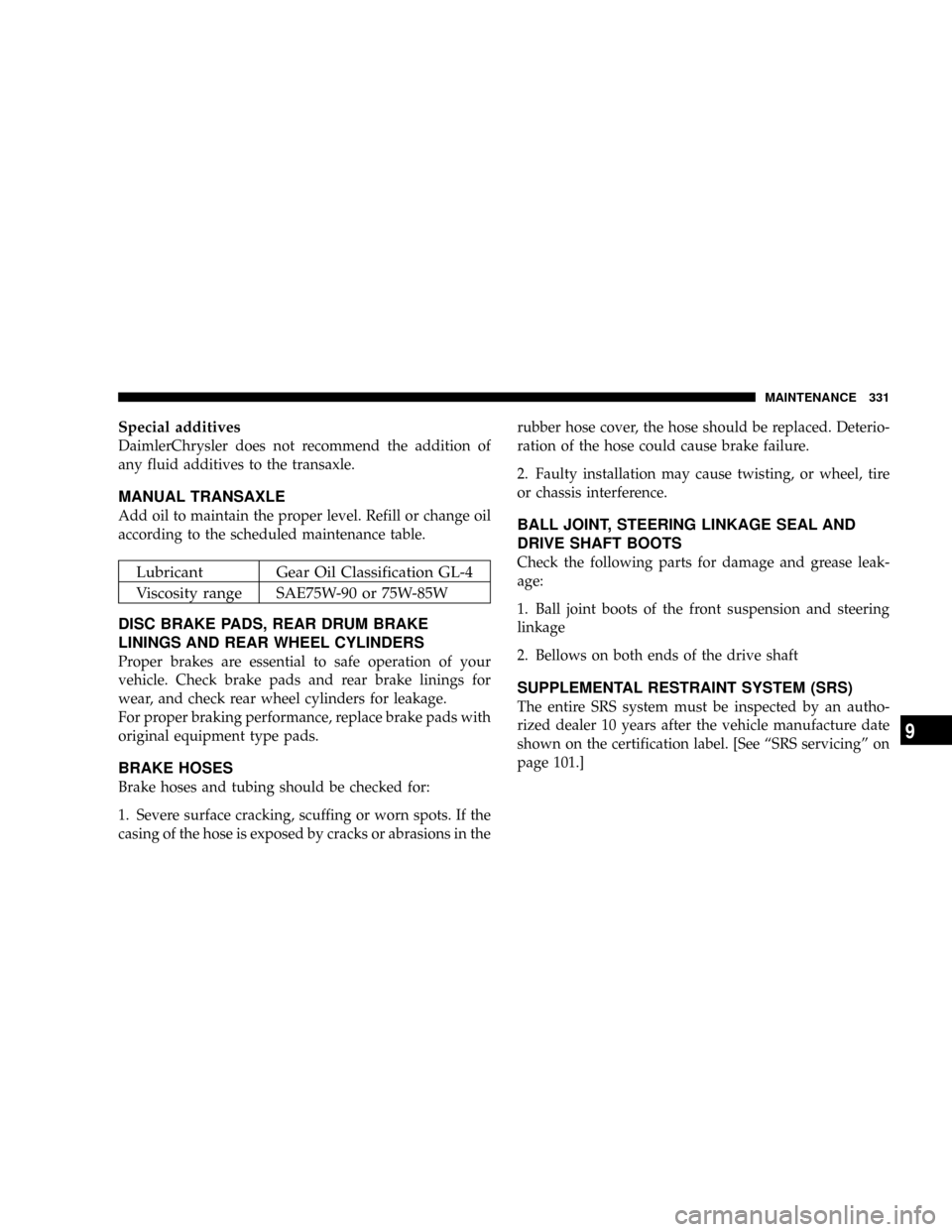Page 309 of 396

MAINTENANCE
CONTENTS
mView of engine compartment..............311
mService precautions.....................312
mEmission-control system maintenance.......313
mEmissions Testing......................314
mOnboard Diagnostic System (OBD II)........314
mReplacement Parts......................315
NFuel system (tank, filler tube, connections,
and fuel tank filler cap).................315
NFuel hoses...........................315
NAir cleaner filter......................316
NEvaporative emission control system
(except evaporative emission canister).......316
NSpark plugs..........................317
NIgnition cables........................317NDistributor cap and rotor................317
mGeneral maintenance....................318
NEngine oil and oil filter..................318
mEngine coolant.........................322
NTo check the coolant level................322
NTo add coolant........................322
mBrake fluid...........................323
mClutch fluid (manual transaxle)............324
NTo check the clutch fluid.................324
NTo replace the fluid....................324
mBattery..............................325
NDuring cold weather...................327
9
Page 310 of 396

NDisconnection and connection.............327
mAutomatic transaxle.....................329
NTo check the fluid level..................330
NProcedure for checking the fluid level.......330
mManual transaxle.......................331
mDisc brake pads, rear drum brake linings
and rear wheel cylinders.................331
mBrake hoses...........................331
mBall joint, steering linkage seal and drive
shaft boots...........................331
mSupplemental Restraint System (SRS)........331
mHood lock release mechanism and
safety catch
...........................332
mExhaust system........................332
mWindshield wiper blades.................333
NWindshield washers....................333
mParking brake.........................334
mDrive belt (for generator, water pump, power
steering pump)
........................335
mTiming belt...........................336
mTi re s................................336
NTire inflation pressures..................340
NRadial ply tires.......................341
N
Tire pressure for sustained high-speed driving...342
NReplacing tire and wheels................342
NTire maintenance......................342
NCargo loads..........................346
NTread wear indicators...................346
NTire rotation.........................347
NTire chains...........................348
NSnow tires...........................348
mRegular Maintenance Schedule.............349
mSevere Maintenance Schedule..............357
310 MAINTENANCE
Page 311 of 396
VIEW OF ENGINE COMPARTMENT
1. Power steering fluid reservoir
2. Engine coolant reservoir
3. Engine oil filler cap
4. Engine oil level dipstick
5. Battery
6. Clutch fluid reservoir (manual transaxle only)7. Brake fluid reservoir
8. Windshield washer reservoir
9. Drive belt
10. Radiator cap
11. Automatic transaxle fluid level dipstick
12. Air cleaner filter
Q02A2510
2.4 liter engine
Q02A2520
3.0 liter engine
MAINTENANCE 311
9
Page 323 of 396

Radiator cap
The radiator cap must be fully tightened to prevent loss
of coolant and engine damage.
WARNING!
Make sure that the engine is thoroughly cooled
down before removing the radiator cap, otherwise
hot steam or boiling coolant may gush from the filler
port and scald you.
Points to remember
1. Do not overfill the reserve tank.
2. A special radiator cap is used to ensure sealing and to
allow the coolant to return from the reserve tank to the
radiator when the engine cools. If cap replacement is
necessary, use the proper cap.
3. Check the coolant freeze point in the radiator using
proper instruments, when it is safe to do so. If antifreeze
is added, the contents of the reserve tank must be
protected against freezing.
4. Keep the front of the radiator clean. Keep the front of
the condenser clean.5. If the temperature of the engine coolant does not rise
normally after engine warm-up, take the vehicle to an
authorized dealer to have the thermostat checked, and
replaced if necessary.
BRAKE FLUID
Recommended brake fluid conforming to DOT 3 or DOT 4
should be used. The reservoir cap must be fully tightened
to avoid contamination from foreign matter or moisture.
CAUTION!
²Do not allow petroleum-based fluid to contact,
mix with, or otherwise contaminate the brake
fluid. Seal damage will result.
²Take care in handling brake fluid as it may cause
damage to painted surfaces.
²Use only the specified brake fluid. Also, the
additives in different brands may result in a
chemical reaction when mixed together, so avoid
mixing different brands if possible.
²Keep the reservoir tank cap closed to prevent the
brake fluid from evaporating or absorbing moisture.
MAINTENANCE 323
9
Page 324 of 396

CLUTCH FLUID (MANUAL TRANSAXLE)
To check the clutch fluid
The clutch fluid in the clutch master cylinder should be
checked when performing other underhood services. In
addition, the system should be checked for leakage at the
same time. Check to make certain that the clutch fluid
level is always between the MAX and MIN level mark-
ings on the fluid reservoir and refill the fluid, if necessary.
A rapid fluid loss indicates a leak in the clutch system
which should be inspected by an authorized dealer and
repaired immediately.
To replace the fluid
Recommended brake fluid conforming to DOT 3 or DOT 4
should be used.
The reservoir cap must be fully tightened to avoid contami-
nation from foreign matter or moisture.
CAUTION!
²Do not allow petroleum-based fluid to contact,
mix with, or otherwise contaminate the clutch
fluid. Seal damage will result.
²Take care in handling clutch fluid as it may cause
damage to painted surfaces.
²Use only the specified clutch fluid.
Also, the additives in different brands may result
in a chemical reaction when mixed together, so
avoid mixing different brands if possible.
²Keep the reservoir tank cap closed to prevent the
clutch fluid from deteriorating due to moisture or
air exposure.
M10A0040
Good
324 MAINTENANCE
Page 330 of 396

To check the fluid level
The fluid level should be checked when the engine
temperature gauge indicates a normal warmed up con-
dition and the fluid in the transaxle is heated to its
normal operating temperature. Operation with an im-
proper fluid level will greatly reduce the life of the
transaxle and the fluid.
Procedure for checking the fluid level
1. With the parking brake engaged and the engine idling,
select each gear momentarily, ending with the selector
lever in the ªNº (NEUTRAL) position.
2. The fluid level should be at the HOT mark, but never
above the HOT mark when the engine is at its normal
warmed up condition. Add or drain as necessary to bring
the fluid to this prescribed level.
3. Make certain that the dipstick cap is reseated properly
to prevent dirt and water from entering the transaxle.
WARNING!
Transaxle fluid is extremely flammable and poison-
ous. Do not spill fluid when adding or draining.
To add or change the fluid
Use only recommended Mopar ATF+4 automatic trans-
mission fluid to ensure optimum transaxle performance.
M05A0460
Drain plug
330 MAINTENANCE
Page 331 of 396

Special additives
DaimlerChrysler does not recommend the addition of
any fluid additives to the transaxle.
MANUAL TRANSAXLE
Add oil to maintain the proper level. Refill or change oil
according to the scheduled maintenance table.
Lubricant Gear Oil Classification GL-4
Viscosity range SAE75W-90 or 75W-85W
DISC BRAKE PADS, REAR DRUM BRAKE
LININGS AND REAR WHEEL CYLINDERS
Proper brakes are essential to safe operation of your
vehicle. Check brake pads and rear brake linings for
wear, and check rear wheel cylinders for leakage.
For proper braking performance, replace brake pads with
original equipment type pads.
BRAKE HOSES
Brake hoses and tubing should be checked for:
1. Severe surface cracking, scuffing or worn spots. If the
casing of the hose is exposed by cracks or abrasions in therubber hose cover, the hose should be replaced. Deterio-
ration of the hose could cause brake failure.
2. Faulty installation may cause twisting, or wheel, tire
or chassis interference.
BALL JOINT, STEERING LINKAGE SEAL AND
DRIVE SHAFT BOOTS
Check the following parts for damage and grease leak-
age:
1. Ball joint boots of the front suspension and steering
linkage
2. Bellows on both ends of the drive shaft
SUPPLEMENTAL RESTRAINT SYSTEM (SRS)
The entire SRS system must be inspected by an autho-
rized dealer 10 years after the vehicle manufacture date
shown on the certification label. [See ªSRS servicingº on
page 101.]
MAINTENANCE 331
9
Page 349 of 396
REGULAR MAINTENANCE SCHEDULE
The content and mileage interval can vary depending on
model.
!6,000 Miles (10 000 km) or at 6 months
NChange engine oil and engine oil filter.
NRotate tires.
MILEAGE/
MONTHSDEALERSHIP
NAME/CODE DATEREPAIR
ORDER #
!12,000 Miles (19 000 km) or at 12 months
NCheck automatic transaxle fluid level.
NInspect disc brake pads, rotors and calipers for
wear and leaks.
NCheck brake hoses for deterioration or leaks.
NInspect drive shaft boots for grease leaks and
damage.
NChange engine oil and engine oil filter.
NRotate tires.
MILEAGE/
MONTHSDEALERSHIP
NAME/CODE DATEREPAIR
ORDER #
!18,000 Miles (29 000 km) or at 18 months
NChange engine oil and engine oil filter.
NRotate tires.
MILEAGE/
MONTHSDEALERSHIP
NAME/CODE DATEREPAIR
ORDER #
MAINTENANCE 349
9